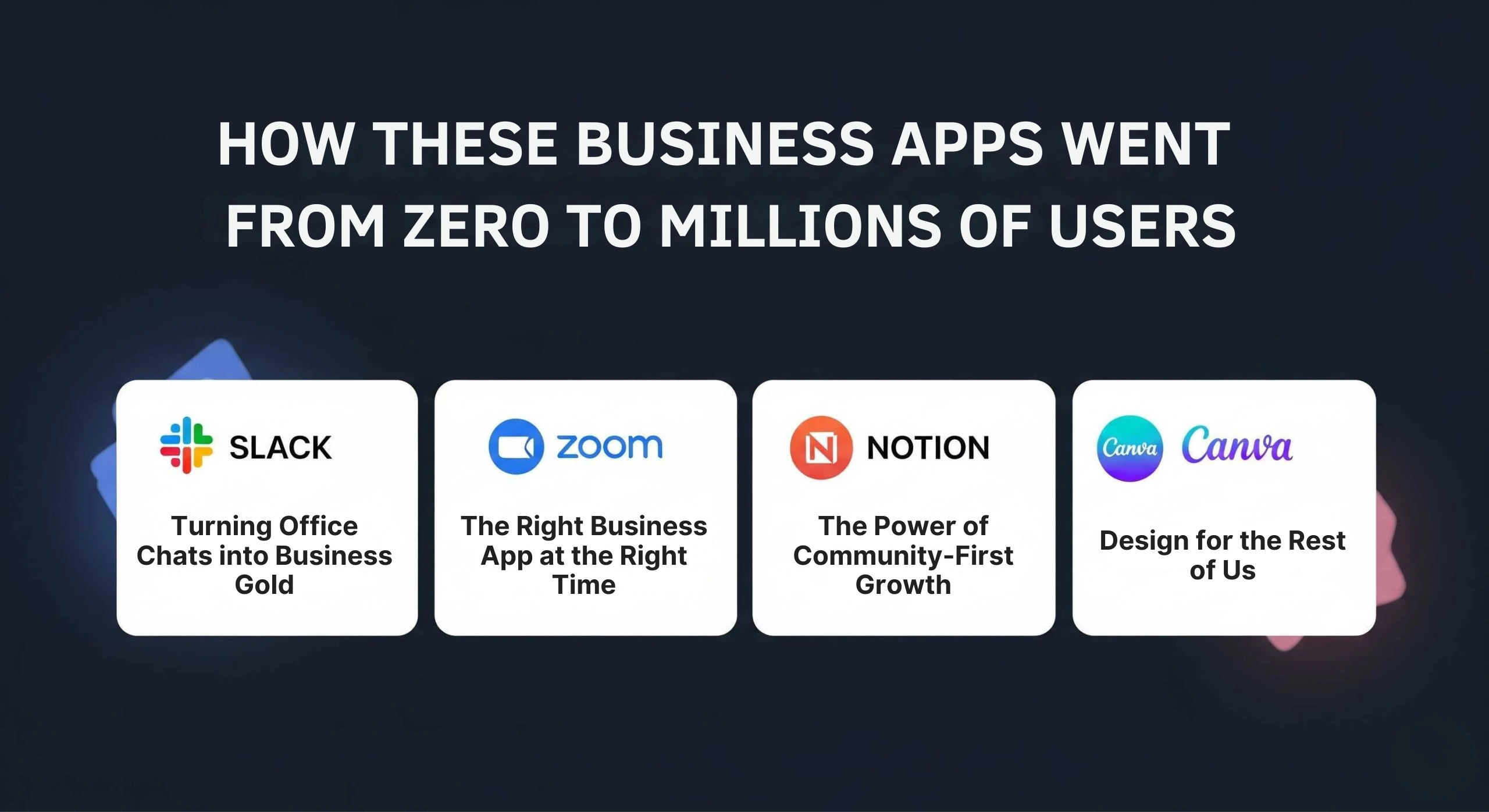How Did These Business Apps Go from Zero to Millions of Users?

Just a few years ago, business apps were mostly boring tools used only when you had to. Today, they’re everywhere. From startups in Hyderabad to remote teams in Berlin, apps like Slack, Zoom, Notion, and Canva have become daily habits for millions.
But here’s the real question:
How did they pull it off?
How did they go from being side projects and small ideas… to becoming billion-dollar brands with massive global reach?
Let’s break down their success stories and the playbook they used so that you, too, can build something users love (and can’t live without).
The Big Shift – What Changed in the World of Business Apps?
Rewind to 2010, and most business software was bulky, slow, and frankly, a bit of a headache. You had to install it, update it manually, and often, only the IT department understood how to use it.
Then came a new wave apps that were:
- Cloud-based (no download needed)
- Mobile-friendly
- Easy to use, even without training
- Built for collaboration from Day 1
This wasn’t just tech evolution. It was a change in behaviour.
People wanted tools that felt like WhatsApp, not Microsoft Excel. Fast. Fun. Frictionless.
And that’s where our heroes enter the scene.
Slack – Turning Office Chats into Business Gold
The story starts with a failure.
Slack was originally built as a side tool for a now-defunct online game. The game flopped, but the team’s internal chat app? That was the real treasure.
Instead of throwing it away, they launched Slack publicly in 2014. Within 6 months:
16,000 users.
By 2015: 2 million.
Today (2025): 42 million people use Slack every day.
What worked?
- Viral team invites – You couldn’t use Slack alone. You had to bring your team.
- Integrations – Google Drive, Asana, Trello, you name it.
- Clean UI – Like texting, but for work.
And unlike old-school emails, Slack made work chats feel natural even fun.
Takeaway: Sometimes your “side project” is your golden ticket. Listen to users, not your ego.
Zoom – The Right App at the Right Time
In a world full of video tools, why did Zoom win?
Because when the pandemic hit in early 2020, Zoom didn’t crash. It just worked.
By March 2020, it had 10 million daily users.
By April: 300 million.
That’s a 2,900% spike. In 30 days.
But here’s the twist: Zoom was already prepared. They had focused on:
- One-click meeting links
- Smooth video, even on patchy Wi-Fi
- Simple mobile and desktop experience
It wasn’t luck it was perfect execution meeting perfect timing.
Takeaway: If your product is rock solid, when the world needs it boom, you’re the go-to.
Notion – The Power of Community-First Growth
Notion didn’t launch with a bang. It grew slowly, under the radar.
But they did something smart:
They didn’t try to push features.
They empowered users to build their own.
From “Second Brain” templates to startup dashboards, people started creating and sharing their own setups on Twitter, YouTube, Reddit.
Suddenly, Notion wasn’t just an app. It was a movement.
By 2019: 1 million users
By 2021: 20 million
By 2025: Well over 40 million, with enterprise adoption on the rise.
What helped?
- Freemium model – No payment wall in the beginning
- Templates – Pre-built systems for everything from journaling to project planning
- Active online community – The fans did the marketing
Takeaway: Build a product people can shape. Empower your users, and they’ll do your branding for free.
Canva – Design for the Rest of Us
Let’s be honest before Canva, designing anything was a pain.
Hiring a designer was expensive. Doing it yourself in Photoshop? Too technical.
Enter Canva in 2013: a simple, browser-based tool built for non-designers.
In 2022: 75 million users
In 2023: 170 million
Today (2025): Over 220 million people use Canva each month across 190 countries.
And get this over 20 billion designs have been created.
So, what did Canva do right?
- Drag-and-drop editing anyone could understand
- Free templates that looked stunning
- Sharing-friendly – Each design became a billboard for Canva
Today, Canva is used by 90% of Fortune 500 and is prepping for a massive IPO.
Takeaway: Solve real frustration and make people feel powerful. That’s your growth engine.
What All These Business Apps Have in Common
While each app’s journey was unique, they all shared these common traits:
Crystal-clear purpose – They solved one real problem really well
Fast iteration – Weekly updates, rapid experiments
User-first design – No fancy fluff, just useful stuff
Freemium model – Let people try before they buy
Community and virality – Templates, invites, shares
These apps didn’t waste time building for “everyone”. They focused on a niche, built love there, and then expanded.
What NOT to Do When Building a Business App
- Don’t chase features. One killer feature beats 20 half-baked ones.
- Don’t market before you validate. Find your product-market fit first.
- Don’t ignore feedback. Some of the best product upgrades came directly from user requests (Notion’s offline mode, for example).
What’s Next in Business Apps?
Looking forward, here’s where the industry is heading:
- AI-led automation: From Zoom’s AI note-takers to Canva’s Magic Write and Notion AI, smart features are becoming the norm.
- Seamless integration: If your app doesn’t work with tools like Zapier, Slack, or Google Workspace, you’re out of the game.
- No-code empowerment: Users want control. Templates, workflows, and drag-drop builders are becoming essentials.
What You Can Learn from These Million-User Apps
You don’t need crores of funding or a 100-member tech team to build something big. What you do need is:
- A sharp focus on one real pain point
- Simple, lovable UX
- Speedy execution and learning
- Listening ears – your users are telling you what they want
These apps succeeded because they built things people actually needed and made it easy and delightful to use them.
So the next time you’re building an app, remember:
You don’t need a unicorn idea. You need real value, delivered well, at the right time.
For expert app development tailored to your business needs, explore our Application Development Services
